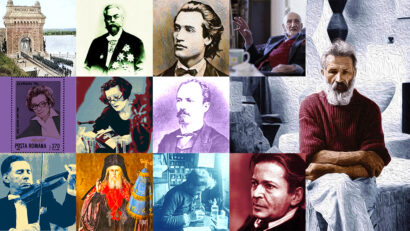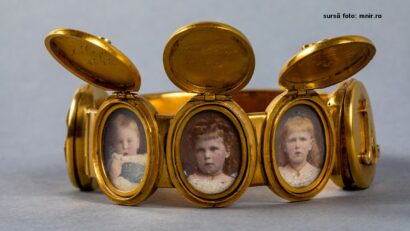Personalities of the Great War
In August 1916, after two years of neutrality, Romania entered WWI on the side of the Entente

România Internațional, 22.12.2018, 12:09
In August 1916, after two years of neutrality,
Romania entered WWI on the side of the Entente. After a period of heavy
fighting and sacrifices, not to mention Bucharest’s occupation by the German
army, Romania got out of the world war stronger and united, in 1918. The
politicians and military of those troubled times have become national heroes,
leaving behind a blazing trail, which is now being documented, with a special
mention of the places and towns that had a special significance in their lives.
A project titled Personalities of WWI and their Bucharest-based dwellings has
recently been initiated by the Arts History Association. Some of their homes,
more or less luxurious villas, have stood the test of time and can now be seen
in the historical areas of the capital city. One
of them is situated in a district which was laid out in the early 20th
Century and called the Ioanid Parcelling Out, after the name of the garden
stretching on a plot of land which was later parcelled out and put up for sale.
Many beautiful villas were built there, and one of them belonged to Vintilă
Brătianu, the then mayor of the capital and the younger brother of Liberal
Ionel Brătianu, Prime Minister and one of the founding fathers of Greater
Romania.
Oana Marinache, a member of the Arts History Association is crayoning
the biography of Vintilă
Brătianu, the mayor of Bucharest when the Ioanid Garden was parcelled out:
He
endorsed the parcelling out of the Ioanid Garden in 1909, andafter he
completed his mandate, he reserved for himself the biggest plot of land in the
area. The vegetal area, the garden or the district’s park were not adjacent to
his property, but Vintilă chose for himself the plot of land at no.25. It was a
matter of fate that after Ionel Brătianu passed away in 1927, his younger
brother, Vintilă, took over the party presidency. In his turn, Vintila, passed
away in 1930. But before leading the party, between 1907 and 1910, he had been
the mayor of Bucharest.
The house built there in Neo-Romanain style by the
prominent architect Petre Antonescu can still be admired today, on Aurel Vlaicu
Street. Oana Marinache has more:
We have a mixture of
influences and styles. For instance the massive volume of the house is
reminiscent of Oltenia’s cule, a sort of semi-fortified buildings, there is
also a gate created under the influence of the vernacular architecture typical
to the sub-Carpathian region. The architectural style specific to monasteries,
particularly the interior of monasteries in Wallachia, has strongly influenced
the building. The construction was soon to become emblematic for early 20th
Century architecture. As a rule, great political personalities convey a message
to the people, not only through the declarations they make, the political
activities they carry out, but also through the lifestyle they embrace. Later
on, after the Great Union, a Transylvanian stove was symbolically built in all
these homes belonging to the personalities of the time. Thus, they tried to
also showcase elements belonging to the province that many Romanians had been
fighting for, some of them paying the ultimate sacrifice for it. It’s a stove
with tiles with black or green drawings against a light background. All boyar mansions
or houses owned by politicians have this type of stove, with motifs that are
also political symbols.
In an office in that house, a secret understanding was
reached with the Entente on August 4th, 1916, a deal that would
subsequently be approved by the Crown Council and which led Romania to war. And
one of those who distinguished themselves during the war was General Henri
Cihoski, a participant in the battle of Marasesti and a deputy with the General
Staff. In December 1920 he became in charge of reorganizing the army in
Transylvania, recently united with Romania, and in 1921 he was assigned the
task to supervise the coronation of King Ferdinand, and also the construction
of the union cathedral in Alba Iulia. His house in Bucharest, designed by Alexandru
Savulescu and built in the modernist style, was finished in 1934 and it’s still
standing in an area next to Ioanid Park, known as the Dumbrava Rosie plot. It
was there that, in the early 1930s, king Carol II rewarded the officers that
had distinguished themselves during the war, by giving them land. One of them
was Henri Cihoski. From that house, where he was living with his family,
Cihoski was arrested in May 1950 by the Communists. He died 11 years later, in
Sighet prison. None of the officers that had taken part in WWI had a better
fate. General Ioan Dragalina, a celebrated hero, died in 1916, after defeating
Romania’s western border as commander of the 1st Infantry Division,
in Drobeta Turnu Severin. Unfortunately, he died on October 24th, of
a septicaemia caused by a shoulder injury.
Here is Oana Marinache once more:
On October 12th, 1916, he left
by car, probably accompanied by another person, besides the driver, on a
surveillance mission. They got caught in a burst fire and attacked by the
Austrian-Hungarian army. Although wounded, he managed to get out alive and was
taken to a hospital in Craiova, then to Bucharest, at king’s orders.
Unfortunately, railway traffic was extremely heavy, the journal took too long
and he developed septicaemia. He died on October 24th, in terrible
pain.
In the inter-war period, in honour of their father,
the general’s children got land in ownership, in the
Bonaparte plot, later renamed Park Ferdinand I. The plot is today home to one
of the most elegant residential areas in the north of Bucharest.





























